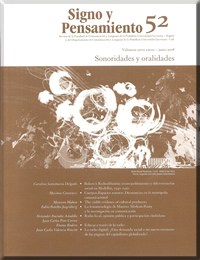Abstract
I intend. to study the Brazilian capoeira from an historic point of view, showing its African heritage and analyzing its meaning from a visual and semantic perspective. It is a sequence of gesture that initially look like a physical exercise, a kind of martial art, but it is really a fight or a dance, depending on the context. Semiotics and kinetics will be used as a framework.Almeida, B. (1981), Capoeira, a Brazilian Art Form, Palo Alto, Sun Wave.
Bernard, M. (1980), El cuerpo, Buenos Aires, Paidós.
Bluteau, R. (1712), Vocabulario portugués e latino, vol. 2, Coimbra, Colégio das Artes da Companhia de Jesus.
Capoeira, N. (1981), O pequeno manual do jogador de capoeira, Sâo Paulo, Grund.
Gil, F. (1989, abril), “Candomblé da Bahia, religiosidade do bahiano”, en O Galo, pp. 12-14.
Gil, J. (1980), Metamorfoses do corpo, Lisboa, Biblioteca de Filosofía.
Greimas, A. K. (1987), Toward a Semiotics of the Natural World. On Meaning, Selected Writings
in Semiotic Theory, Londres, Frances Printer.
Heves, G. W. (1973), “Primate Communication and the Gestual Origin of Language”, en Current Anthropology, vol. 14, núm. 11-2, pp. 5-24.
Holanda Ferreira, A. B. de (1986), Novo dicionário da lingua portuguesa, 2ª ed., Rio de Janeiro,
Nova Fronteira.
Huizinga, J. (1955), Homo ludens. A Study of the Play Element in Culture, Boston, Beacon Press.
Johnson, M. (1987), The Body in the Mind, Chicago, Chicago University Press.
Lapa, M. R. (1965), Cantigas d’escarnho e de mal’dizer dos cancioneiros medievais galegoportugueses, Coimbra, Galaxia.
Lewis J., L. (1992), Ring of Liberation. Deceptive Discourses in Brazilian Capoeira, Chicago, University of Chicago Press.
Lody, R. (1987), Candomblé, religião e resistência cultural, Sâo Paulo, Ática.
MacCannell, D. (1986), “Sight and Spectacles. Iconicity. Essays on the Nature of Culture”, en Bouissac, P., Herzfeld, M. y Posner, R. (edits.), Festschrift for the 65th anniversary of Thomas A. Sebeok, Tübingen, Stauffenburg Verlag, pp. 421-435.
Megenney, W. W. (1978), A Bahian Heritage, an Ethnolinguistic Study of African Influences on
Bahian Portuguese, Chapel Hill, University of North Carolina Press.
Morais Filho, M. (1946), Festas e tradições populares do Brasil, Rio de Janeiro, F. Briguiet & Cia.
Poyatos, F. (1977), “The Morphological and Functional Approach to Kinesics in the Context
of Interaction and Culture”, en Semiotica, vol. 20, núms. 3-4, pp. 197-228.
Querino, M. (1938), Costumes africanos no Brasil, Rio de Janeiro, Civilização Brasileira.
Rego, W. (1968), Capoeira. Angola, ensaio sócioetnográfico, Salvador, Itapuã.
Rector, M. (1984), “The Code and Message of Carnival. Escolas de Samba” (con Eco, U., Ivanov,
V. V.), en Sebeok, T. A. (edit.), Carnival, New York, Mouton, pp. 37-165.
—, y Trinta, A. R. (1985), Comunicação não-verbal, a gestualidade brasileira, Petrópolis, Vozes.
Sebeok, T. A. (1981), The Play of Musement, Bloomngotn, Indiana University Press.
Soares, A. J. de M. (1880), “Estudos lexicográficos do dialeto brasileiro”, en Revista Brasileira,
vol. 1, num. 3.
Tavares, J. C. de S. (1984), Dança da guerra. Arquivo-arma [tese de mestrado], Brasilia,
Universidade de Brasilia.
— (1990), “Corporeidade étnica e social”, en Revista de Cultura, Vozes, num. 2, pp. 133-156.
Verger, P. (1966), O fumo da Bahia e o tráfico dos escravos no golfo de Benim, Salvador, Fundação
Gonçalo Muniz-Centro de Estudos Afro-Orientais-Universidade Federal da Bahia.

This work is licensed under a Creative Commons Attribution 4.0 International License.
Copyright (c) 2021 Mónica Rector


